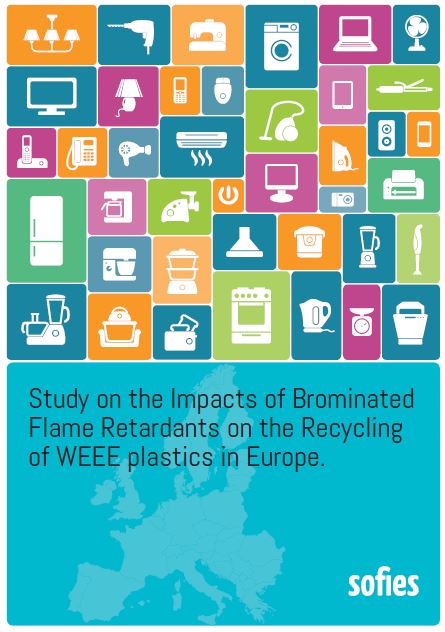BSEF response to the Nordic Council of Ministers report “Circular Plastics in Electrical and Electronic Equipment”
21 January 2022
On the 3rd of January 2022 the Nordic Council of Ministers issued a report on recyclable plastic components in electrical and electronic products with the title “Circular plastics in electrical and electronic equipment”[1]. The report presents an inaccurate portrayal of waste from electrical and electronic equipment (WEEE). WEEE recycling and the impact of flame retardants” by concluding that Brominated Flame Retardants (BFRs) should be designed out of products in order to support the recycling of plastics from EEE.
BSEF, The International Bromine Council, refuses these allegations. In contradiction to the report by the Nordic Council of Ministers, BFRs are not hindering the recycling of WEEE plastics and are safe for use in accordance with the REACH regulation.
THE IMPORTANCE OF FLAME RETARDANTS IN ELECTRONIC APPLIANCES
Electronic and electrical equipment uses plastics to make products lighter, more innovative, and cost effective. Brominated Flame Retardants (BFRs) are substances that change the nature of combustible plastic materials used in electrical and electronic equipment making them more fire ignition resistant.[2] In most products they primarily stop fires from starting – No Ignition No Fire. BFRs are often used in EEE plastics to meet fire safety standards and protect consumers from accidental fires. Their value should not be dismissed as they play a essential role in Fire Safety in Europe[3].
For example, televisions were the first ‘modern’ electrical appliances to be found in virtually every home. Although the plastic in the average LCD TV has the same potential to generate the heat as six litres of petrol, the inclusion of modern flame retardants makes them more fire resistant.
BROMINATED FLAME RETARDANTS ARE NOT HINDERING THE RECYCLING OF WEEE PLASTICS
 BSEF, The International Bromine Council, released in 2020 a comprehensive report regarding WEEE plastics flows and recycling efforts in Europe – Impact of Brominated Flame Retardants on the Recycling of WEEE plastics[4]. The report, undertaken by a leading sustainability consultancy, SOFIES, uniquely addresses misperceptions regarding the impact of BFRs on WEEE plastics recycling and presents the successes and overarching challenges in making WEEE plastic streams more circular.
BSEF, The International Bromine Council, released in 2020 a comprehensive report regarding WEEE plastics flows and recycling efforts in Europe – Impact of Brominated Flame Retardants on the Recycling of WEEE plastics[4]. The report, undertaken by a leading sustainability consultancy, SOFIES, uniquely addresses misperceptions regarding the impact of BFRs on WEEE plastics recycling and presents the successes and overarching challenges in making WEEE plastic streams more circular.
- Approximately 2.6 million tons of WEEE plastics are generated annually in Europe; Plastic containing BFRs represent about 9% of this total.
- Around half of all WEEE plastics generated in Europe do not enter official WEEE collection channels, ending up in the waste bin, processed at substandard recycling facilities, or exported outside Europe.
- On average, 55% of WEEE plastics entering specialized WEEE plastic recycling facilities are effectively recycled, i.e. turned into Post-Consumer Recycled plastics that can be used in the manufacture of new plastics products.
- Restricted BFRs (e.g. Octa-BDE and Deca-BDE) only represent a small and rapidly declining fraction of all BFRs found in WEEE plastic streams reflecting the restriction on the use of these substances for more than a decade (2003 for Octa-BDE, 2008 for Deca-BDE).
- The presence of BFRs in WEEE plastics does not reduce recycling yields more than other FRs as FR-containing plastics, as well as plastics containing other additives in significant loads (e.g. fillers), are sorted out during the conventional density-based recycling process.
This report was supported by APPLiA, the voice for the home appliance industry in Europe
“As devices continuously evolve to the complex and smart appliances we see today, ensuring consumer safety is preserved at all stages is a key priority for the home appliance industry. This couples with the sectoral effort towards enhancing the circularity of products and processes, from the design phase to end-of-life of products, requiring prompt action from all players in the value chain towards the implementation of a circular model that benefits the economy, the environment and the overall society while preserving the safety of all European consumers.”
REQUIREMENTS FOR BFR PLASTICS SEPARATION
The WEEE Directive requires the segregation of plastics containing restricted BFRs during the treatment of WEEE, and the CEN standard on WEEE treatment (EN 50625) specifies the modalities of this segregation. Plastics from screens and small appliances must undergo a BFR separation method able to separate a Br-poor fraction that can be recycled, and a Br-rich fraction that shall be disposed of.
On the report “Impact of Brominated Flame Retardants on the Recycling of WEEE plastics”, feedback from WEEE plastic recyclers confirmed that BFR plastics represent nowadays a well-controlled stream, which is easily sorted out during conventional and industrial recycling processes. They are, therefore, not a hindrance to the recycling of WEEE plastics.
A report published by EERA, The European Electronics Recyclers Association, in 2018 shows clearly how WEEE recyclers treat mixed plastics with Best Available Technology in compliance with WEEE and POP regulation[5].
CHEMICAL SAFETY OF FLAME RETARDANTS
In addition, the Nordic Council of Ministers report says that “Not only do these chemicals [flame retardants] slip through the regulatory framework, their presence in EEE on the European market are also relatively under-studied”.
Flame retardants include a wide range of chemistries, which act in different ways, based on the chemistry and their final application. Chemical safety in products is the domain of chemical regulators and thanks to the EU REACH Regulation, all chemicals produced in the EU over 1 tonne per annum undergo extensive research and testing to ensure safe use in their designated application. Registration under REACH is a pre-requisite to placing any substance such as new chemical FR on the market.
To conclude, Flame retardants are part of the fire safety toolbox protecting people and property
from fires and their use is evaluated by regulations. The presence of BFRs in electric and electronic equipment are not hindering the recycling of WEEE plastics as the WEEE recycling industry has the correct processes in place.
Download position here:
Media Contact
For all enquiries please contact:
About BSEF
BSEF – The International Bromine Council, is the global representative body for bromine producers and producers of bromine technologies. Originally founded in 1997, BSEF works to foster knowledge on the societal benefits of bromine and its applications. The members of BSEF are Albemarle Corporation, ICL Industrial Products, Lanxess and Tosoh
[1] Circular plastics in electrical and electronic equipment report – https://www.norden.org/en/publication/circular-plastics-electrical-and-electronic-equipment
[2] Flame retardants guide: preventing fires, protecting people – http://flameretardantsguide.com/flame-retardants-applications/electronics-and-electrical-equipment/
[3] 10 actions that will improve Fire Safety in Europe – https://www.europeanfiresafetyalliance.org/our-focus/
[4] Study on the Impacts of Brominated Flame Retardants on the Recycling of WEEE plastics in Europe. https://www.bsef.com/wp-content/uploads/2020/11/Study-on-the-impact-of-Brominated-Flame-Retardants-BFRs-on-WEEE-plastics-recycling-by-Sofies-Nov-2020-1.pdf
[5] Responsible recycling of WEEE plastics containing Brominated Flame Retardants- BFR’shttps://www.eera-recyclers.com/files/eera-bfrs-folder-online.pdf


